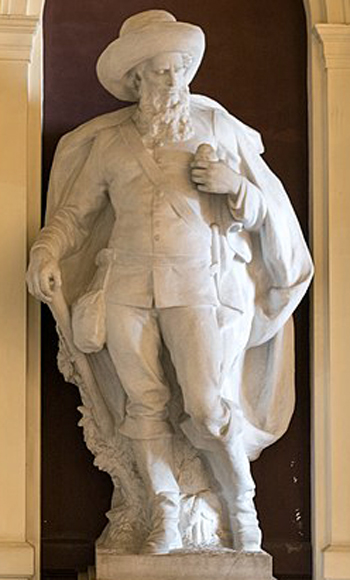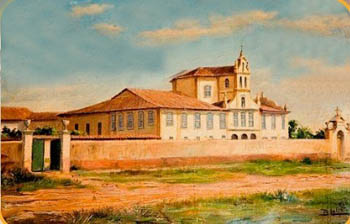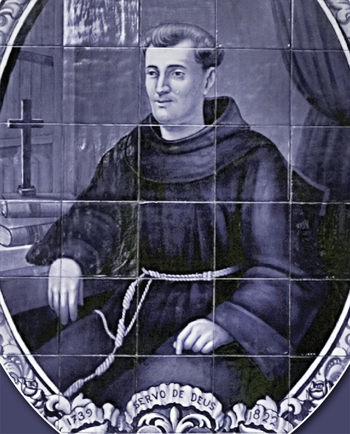Saints of the Day
 |
 |
 |
 |
 |
 |
 |
Ven. Fray Antonio Galvão - December 23
Biographical Selection:
Fray Antônio de Sant'Anna Galvão was born in Guaratinguetá in the State of São Paulo, Brazil, on May 10, 1739 to a good family. His father was Captain-General of the city; his mother was a daughter of a large rancher who descended from the known Bandeirante explorer, Fernão Dias Paes. (1) Both were very devout Catholics.
 At age 13 his parents sent him to a Jesuit seminary in Cachoeira in the State of Bahia. Later, due to the growing persecution of the Jesuits, who ended by being expelled from Portugal and Brazil in 1759, he moved to a Franciscan seminary in Rio de Janeiro. In April 1762 he was ordained a priest and was transferred to St. Francis Friary in São Paulo.
At age 13 his parents sent him to a Jesuit seminary in Cachoeira in the State of Bahia. Later, due to the growing persecution of the Jesuits, who ended by being expelled from Portugal and Brazil in 1759, he moved to a Franciscan seminary in Rio de Janeiro. In April 1762 he was ordained a priest and was transferred to St. Francis Friary in São Paulo.
In February 1774, Fray Galvão founded the Convent of Our Lady of the Light (Convento da Luz) in the city of São Paulo and became its director. The new Convent was incorporated into the Order of the Immaculate Conception or the Conceptionists, a feminine branch of the Franciscan Order. He wrote the statutes for the formation of its nuns.
Fray Galvão could read souls and was often seen levitating in his prayer. He would also be in two different places at one time in order to take care of sick or dying persons who asked for his help.
He died on December 23, 1822, in the Convent of the Light and was buried in its Church. Soon his tomb became a place of pilgrimage due to the graces and favors the faithful received through his intercession.
The fame of his sanctity was solidly established even during his life. So many persons present at his funeral wake cut off small pieces of his habit to have as relics that finally it barely covered his knees, and had to be replaced by another habit so that he could be properly buried.
Thenceforth, many came to the Convent to ask for the "paper pills" of Fray Galvão, which healed many from both physical and spiritual troubles. These "pills" are made of paper touched at his tomb rolled in small balls or capsules. Those who swallow these "pills" become cured of his deseases; the "pills" are principally popular among pregnant women with problems in order to have a happy delivery.
TIA Note: The following comments by Prof. Plinio are excerpts from an article he wrote in 1974 about the Convent of the Light and the role of Fray Galvão in an important episode of its history. They are not comments based on the biographical selection above, which we have included in order to provide a historical context for the reader about Fray Galvão's life.
Comments of Prof. Plinio:
In June of 1775 the term of Luiz Antônio Botelho e Mourão as the Captain General of São Paulo ended. (2) He had governed it with wisdom, firmness and goodness. His successor was Martim Lopes de Saldanha, under whose iron fist São Paulo endured eight years of despotism and arbitrary decisions.
 Lopes, a zealous enforcer of the laws persecuting the Church issued by the anti-clerical Marquis of Pombal (3), did not delay in communicating to the Viceroy Marquis of Lavrado that he had ordered the closing of the Convent of the Light where 10 nuns lived.
Lopes, a zealous enforcer of the laws persecuting the Church issued by the anti-clerical Marquis of Pombal (3), did not delay in communicating to the Viceroy Marquis of Lavrado that he had ordered the closing of the Convent of the Light where 10 nuns lived.
Lopes communicated the closing order to the submissive Bishop of São Paulo. On June 29, the Feast of St. Peter, the Bishop called Fray Galvão – the chaplain and protector of the small Catholic order – and ordered him under obedience to start the dissolution of the Convent.
After the order was given by the Bishop – whose actual duty, however, was to protect the religious women and not to disperse them – Fray Galvão went to the Convent. Its Chapel was packed with people waiting for his Mass. After it, he communicated to the sorrowful nuns the arbitrary decision that would dissolve them. He told them to advise their families to come to take them to their homes because in a month the Convent would close its doors.
Three religious women left, but the others decided to resist the schemes of the Governor endorsed by the Bishop, while remaining within the limits of the Canon Law. The order commanded them to close the Convent, but not, however, to leave it. They closed it, but decided to continue to live there clandestinely.
The resistance seemed absurd because once they were discovered by the Governor or the Bishop, the authorities had the power – although not the right – to issue strong canonical and civil penalties against the religious women. How could they survive in the cloistered life without receiving the needed foodstuff and water from the outside? How could the sisters enter into contact with persons outside the Convent without the risk of being reported?
Their persistence looked absurd to creatures without faith, but not for those who believe that faith can move mountains. The nuns resolved to face what was humanly impossible. They shuttered the doors and windows and cut off all contact with the outside world.
After their small store of food was gone, the nuns were able to survive from vegetables planted in their courtyard. In the meantime, a squash plant started to produce such an abundance of fruit that the religious women were unable to eat them all.
 When the nuns were desperately in need of water, they met in the Chapel choir on a pleasant cloudless day and prayed for rain. Almost immediately the sky began to cover with clouds; it thundered, and a copious rain fell over the Convent and filled all the buckets and pans that the sisters had set out to collect it. Once the containers were full, the rain stopped.
When the nuns were desperately in need of water, they met in the Chapel choir on a pleasant cloudless day and prayed for rain. Almost immediately the sky began to cover with clouds; it thundered, and a copious rain fell over the Convent and filled all the buckets and pans that the sisters had set out to collect it. Once the containers were full, the rain stopped.
Heaven gave the "resisters" still greater spiritual assistance. Joy inundated the souls of the nuns, who in those catacombs received remarkable graces.
For a whole month this holy resistance continued. Several more days passed when suddenly strong blows on the door made the community tremble. Had they been discovered? Would they be taken to jail?
They listened closely and heard the voice of Fray Galvão, who was calling them by their names. They opened the door. Radiant with joy, he told them the news that the Viceroy Marquis of Lavrado had cancelled the order to close the Convent and decided to allow it to re- open. A letter had just arrived from Rio de Janeiro communicating the command, with which the Bishop had hastily complied. The hour of reward arrived for the victorious nuns, the hour of the Te Deum and the Magnificat…
These facts, which I found in the well-documented book Frei Galvão, o Bandeirante de Cristo (Fray Galvão the Banner-Carrier of Christ), reveals not only the vigor of soul of the religious women but also of Fray Galvão. It seems obvious to me that he knew of their resistance and supported it. Otherwise, how could he have known that they were still in the boarded-up and closed Convent?

The Saint of the Day features highlights from the lives of saints based on comments made by the late Prof. Plinio Corrêa de Oliveira. Following the example of St. John Bosco who used to make similar talks for the boys of his College, each evening it was Prof. Plinio’s custom to make a short commentary on the lives of the next day’s saint in a meeting for youth in order to encourage them in the practice of virtue and love for the Catholic Church. TIA thought that its readers could profit from these valuable commentaries.
The texts of both the biographical data and the comments come from personal notes taken by Atila S. Guimarães from 1964 to 1995. Given the fact that the source is a personal notebook, it is possible that at times the biographic notes transcribed here will not rigorously follow the original text read by Prof. Plinio. The commentaries have also been adapted and translated for TIA’s site.
Fray Antônio de Sant'Anna Galvão was born in Guaratinguetá in the State of São Paulo, Brazil, on May 10, 1739 to a good family. His father was Captain-General of the city; his mother was a daughter of a large rancher who descended from the known Bandeirante explorer, Fernão Dias Paes. (1) Both were very devout Catholics.

An ancestor of Frei Galvao, the famous Bandeirante Fernão Dias Paes; below, Frei Galvão

In February 1774, Fray Galvão founded the Convent of Our Lady of the Light (Convento da Luz) in the city of São Paulo and became its director. The new Convent was incorporated into the Order of the Immaculate Conception or the Conceptionists, a feminine branch of the Franciscan Order. He wrote the statutes for the formation of its nuns.
Fray Galvão could read souls and was often seen levitating in his prayer. He would also be in two different places at one time in order to take care of sick or dying persons who asked for his help.
He died on December 23, 1822, in the Convent of the Light and was buried in its Church. Soon his tomb became a place of pilgrimage due to the graces and favors the faithful received through his intercession.
The fame of his sanctity was solidly established even during his life. So many persons present at his funeral wake cut off small pieces of his habit to have as relics that finally it barely covered his knees, and had to be replaced by another habit so that he could be properly buried.
Thenceforth, many came to the Convent to ask for the "paper pills" of Fray Galvão, which healed many from both physical and spiritual troubles. These "pills" are made of paper touched at his tomb rolled in small balls or capsules. Those who swallow these "pills" become cured of his deseases; the "pills" are principally popular among pregnant women with problems in order to have a happy delivery.
TIA Note: The following comments by Prof. Plinio are excerpts from an article he wrote in 1974 about the Convent of the Light and the role of Fray Galvão in an important episode of its history. They are not comments based on the biographical selection above, which we have included in order to provide a historical context for the reader about Fray Galvão's life.
Comments of Prof. Plinio:
In June of 1775 the term of Luiz Antônio Botelho e Mourão as the Captain General of São Paulo ended. (2) He had governed it with wisdom, firmness and goodness. His successor was Martim Lopes de Saldanha, under whose iron fist São Paulo endured eight years of despotism and arbitrary decisions.

The Convent of Light in the 19th century
Lopes communicated the closing order to the submissive Bishop of São Paulo. On June 29, the Feast of St. Peter, the Bishop called Fray Galvão – the chaplain and protector of the small Catholic order – and ordered him under obedience to start the dissolution of the Convent.
After the order was given by the Bishop – whose actual duty, however, was to protect the religious women and not to disperse them – Fray Galvão went to the Convent. Its Chapel was packed with people waiting for his Mass. After it, he communicated to the sorrowful nuns the arbitrary decision that would dissolve them. He told them to advise their families to come to take them to their homes because in a month the Convent would close its doors.
Three religious women left, but the others decided to resist the schemes of the Governor endorsed by the Bishop, while remaining within the limits of the Canon Law. The order commanded them to close the Convent, but not, however, to leave it. They closed it, but decided to continue to live there clandestinely.
The resistance seemed absurd because once they were discovered by the Governor or the Bishop, the authorities had the power – although not the right – to issue strong canonical and civil penalties against the religious women. How could they survive in the cloistered life without receiving the needed foodstuff and water from the outside? How could the sisters enter into contact with persons outside the Convent without the risk of being reported?
Their persistence looked absurd to creatures without faith, but not for those who believe that faith can move mountains. The nuns resolved to face what was humanly impossible. They shuttered the doors and windows and cut off all contact with the outside world.
After their small store of food was gone, the nuns were able to survive from vegetables planted in their courtyard. In the meantime, a squash plant started to produce such an abundance of fruit that the religious women were unable to eat them all.

Holy cards, papers touched in Fray Galvao's tomb & his ‘pills’ - articles highly solicited by the faithful
Heaven gave the "resisters" still greater spiritual assistance. Joy inundated the souls of the nuns, who in those catacombs received remarkable graces.
For a whole month this holy resistance continued. Several more days passed when suddenly strong blows on the door made the community tremble. Had they been discovered? Would they be taken to jail?
They listened closely and heard the voice of Fray Galvão, who was calling them by their names. They opened the door. Radiant with joy, he told them the news that the Viceroy Marquis of Lavrado had cancelled the order to close the Convent and decided to allow it to re- open. A letter had just arrived from Rio de Janeiro communicating the command, with which the Bishop had hastily complied. The hour of reward arrived for the victorious nuns, the hour of the Te Deum and the Magnificat…
These facts, which I found in the well-documented book Frei Galvão, o Bandeirante de Cristo (Fray Galvão the Banner-Carrier of Christ), reveals not only the vigor of soul of the religious women but also of Fray Galvão. It seems obvious to me that he knew of their resistance and supported it. Otherwise, how could he have known that they were still in the boarded-up and closed Convent?
- A bandeirante was a first-generation Portuguese explorer/colonizer who established himself in Brazil. He was one of those adventurers who would go into the inland forests and expand the limits of Brazil much further than those boundaries established by the Tordesilhas Treatise. They would bring with them bandeiras, that is flags, to mark the new borders of Brazil. Hence their name: bandeirantes - flag bearers. Those men were considered heroes by the Brazilians, especially by those of the State of São Paulo from which most of them came.
- Captaincy of São Paulo was the name of the State of São Paulo when Brazil was Vice-Kingdom of Portugal. Since Brazil was a Colony of Portugal, its territory was divided into Hereditary Captaincies. Many of them gave origin to the present day States of Brazil; one of them was the Captaincy of São Paulo. Thus, the General Captain was the equivalent of a governor.
- The Marquis of Pombal (Sebastião de Carvalho - 1699-1782) was a Freemason Prime Minster of the Kingdom of Portugal. For about 25 years he enforced a rigorous persecution against the Catholic Church and in 1759 expelled the Jesuits from Portugal and Brazil.
 | |
|
|
The texts of both the biographical data and the comments come from personal notes taken by Atila S. Guimarães from 1964 to 1995. Given the fact that the source is a personal notebook, it is possible that at times the biographic notes transcribed here will not rigorously follow the original text read by Prof. Plinio. The commentaries have also been adapted and translated for TIA’s site.